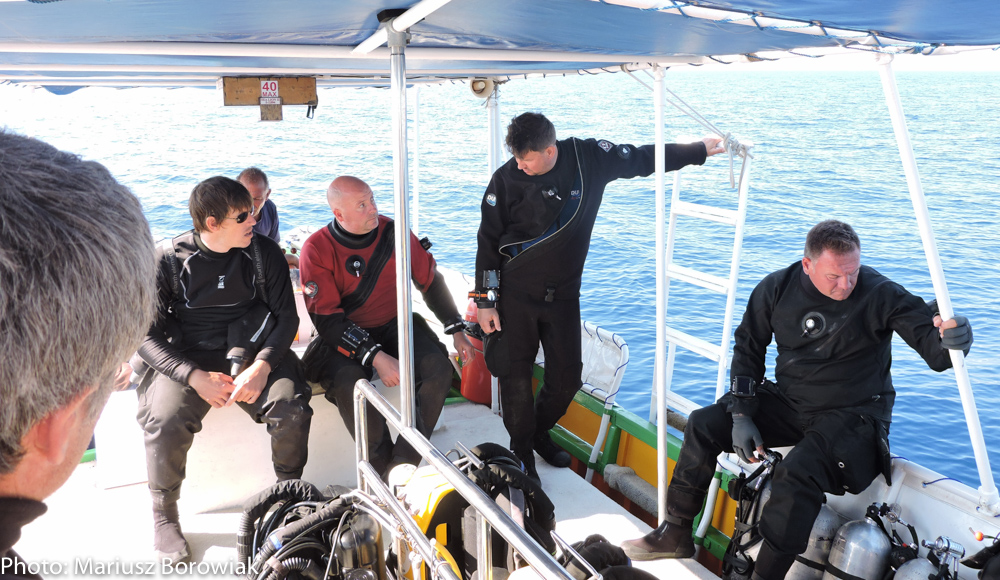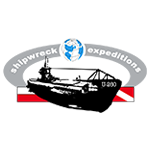
Kujawiak 2016 Season Finale: They found the HEART of L72!
Members of the international expedition have been anticipating their final chance of the expedition to dive on the wreck of the ORP Kujawiak. The group was apprehensive about the day’s mission due to strong winds and underwater currents, which had hampered their 100-meter descents, and technical problems with their advanced equipment which had now taken a key diver out of the team. The possibility of finding the ship’s bell was in question. Today’s search for the valuable artifact, were it to be carried out at all, would be carried out with difficulty.
After the success of finding the wreck of the escort destroyer Kujawiak in 2014, and the first exploratory expedition in 2015, the team had been confident that finding the ship’s bell was just a matter of time. The association had, so far, experienced success with each new expedition and were well prepared for the third trip to Malta. Before leaving, the team thoroughly acquainted themselves with the rich historical material and addressed all of the applicable legal and logistical aspects. Official permission had been obtained from Malta state authorities as well as from researchers from the University of Malta, who lauded the effort. “Each year, we have a specific plan for the Kujawiak, which sank after striking an enemy mine in June, 1942, just a few nautical miles off the coast of Valletta. Our equipment was well prepared and the team had experienced divers,” said Peter Wytykowski.
Although for many years we have organized expeditions to shipwrecks without the help of outside financing, each expedition requires careful planning. Our achievements are well known in the diving community. We quickly made plans for the next expedition,” said Roman Zajder, President of the Shipwreck Expedition Association. However, the final days of the expedition had brought difficulty for the underwater detectives. Starting with their arrival to Malta the team had been plagued by various unforeseen difficulties related to the search for the ship’s bell.
On June 15, they had arrived at the wreck site by boat. While the weather was perfect for their planned exploration, the current — though somewhat improved — still was unforgiving. Upon arrival at the site, problems had begun to stack up, including multiple cases of equipment failure. These had resulted in a downsizing of the dive team, revisions to gas management plans, and a consequential reduction of bottom time appropriately imposed by the safety officers, in addition to leaving some non-essential equipment on the surface. Since this also meant a curtailment of the search range, they did not have much hope for success.
“I was skeptical about the next dive. After the equipment failure, members of the team felt that their plans had been thwarted by fate.”, reported Peter Wytykowski.
However, in the face of that uncertainty, and with no absence of debate, a decision to dive was made. The pared-down first team, who would have primary responsibility for the search, approached the boat’s gunwale. With assistance from the surface support team to manage their leashed deco cylinders, leapt into the water, performed their checks, and disappeared below the waves.
The next several minutes saw a continued flurry of activity above. Two more teams had to be deployed on a tight schedule: the second wreck team and mid-water support. The second team, consisting of Steve Wilkinson and Edd Stockdale of Shadow Technical, are the logistics team and DSOs of the expedition. They had a separate and distinct – but no less important – task to perform. The mid-water support team needed to descend on a schedule that put them on-station at depth by the time the first team was ascending, but well after the second team hit bottom. That meant getting the second team kitted and off the boat no more than ten minutes after the first team’s entry, then repeating the process and splashing support at the fifteen minute mark.
For these few minutes, most minds were momentarily too occupied to consider what was going on below. That is, except for those of midwater support. Sitting quietly in his drysuit, Scott DellaPeruta watched Edd and Steve while assistants helped strap what are, essentially, portable mixing stations and gas recycling systems to their backs, clip on their heavy steel cylinders (most divers carried a total of five to seven, large and small), and apply their masks, fins, lights, and cameras and other secondary equipment, just as he had helped Sharky and Peter. He was now waiting for space and crew to become available to perform the same transformation on him. He thought about the first team currently on the wreck, about the upsets and pressures of the day, and about the diver and resources they’d had to leave behind. He thought about the second team’s potentially demanding dive plan and the currents that had blown them down like reeds a few days before, causing them to deplete their CO2 adsorbents and most of their deco. Mostly, he thought about his job. The precious bell was only a distant hope at this point. More important was that everyone return safely.
. . . . . . . . .
Having paused their ascent for an obligatory decompression stop, first-team members Wytykowski and Alexander were met by Scott, a human gas station whose main purpose on this dive was to bear extra decompression cylinders in case of unforeseen complications or delays in the dive schedule for either team. Coming within range of Sharky first, Scott gave the visual “OK?” query. Sharky waved back a quick “OK” but motioned down the line toward Peter. With what was now an elevated sense of urgency, Scott quickly leveled himself with Peter, who began shouting something through his loop.
Anyone who’s dived open circuit scuba knows that, although sound carries well through water, it is virtually impossible to articulate actual language while blowing bubbles through a regulator. Rebreather divers, on the other hand, usually can produce fairly intelligible vocals within their closed circuit systems, even with the mouthpiece between their lips. Usually, but perhaps less so when excited or stressed. Peter was clearly in one of those categories.
“Free hhaaarng nabboo!”
<Shrug>
What?
“Vuu flarmdubbull!”
“Wuf wrong?”
“Vwee. Frond. Də. Bell!”
“You frowned it. Sheeruzly?”
<crazed nod>
…..<hmm>…..
…..[Hand signal]: <OK?>
<OK.>
. . . .
[To Sharky:] “Heesh polling my weg, white?”<Firm negative.>
<High fives>
. . . . . . . . .
After returning to the surface, Peter informed the other members of the team and recounted their discovery.
“We had about 20 minutes of bottom time to search. I was buddied with Mark ‘Sharky’ Alexander. Our time underwater was fast approaching its end. In a few moments, we had to prepare for more than two hours of decompression. Driven by a premonition, I signaled my partner to swim towards one of the unexplored places on the wreck. Suddenly, I felt a thrill of delight. I gave a cry of joy, which did not go unnoticed by my partner. We has seen ‘our’ ship’s bell”, related Wytykowski.
We’d done it! Unfortunately, the team had been short by not only one diver, but also the GoPro he was to carry. Moreover, expedition member Gianmichele Iaria and his cinematic rig, who had accompanied the first team on previous dives, had already wrapped and headed home. Agreeing that they must somehow return to the ship the next day to document the find, Peter and Sharky had returned to the up-line and begun their long ascent.
They were overcome with joy on the discovery, but while Wytykowski, too, was ecstatic, he was angry with himself for not having taken the camera on the dive.
. . . . . . . . .
Meanwhile, Steve Wilkinson and Edd Stockdale had been on a different mission. They had descended minutes after the first team in order to perform a video survey of the fallen, original mooring line in order to plan its eventual recovery. (Fortunately, they found that it was not too fouled and did not appear to have done damage.) Their tour of the ship eventually brought them upon Wytykowski and Alexander’s departure point.
Unaware of the nature of the drama that had just occurred, they had ventured toward the spot that their colleagues had vacated moments before. It was there that they, too, saw the Kujawiak’s bell. Wilkinson used his GoPro camera under Stockdale’s lights to shoot enough video to document the bell’s location, condition, and conditions for extraction.
. . . . . . . . .
The celebrations at the surface had subsided, but were not the end. While Edd and Steve decompressed, the topside and first dive teams had no knowledge of what they had done below. For the next hour or so, that secret would be well kept under six meters of water. When the Shadow team were finally onboard the boat, they revealed that they had the footage. Once again, the wreck had yielded its secrets.
Finally, I experienced the thrill which overcame me during the first exploration of the ship. Now we have completed our quest with the discovery of the ship’s bell. I am grateful to my colleagues that from the beginning to the end supported me in different ways in the search for the Kujawiak.”
— Peter Wytykowski
Beginning with the first expedition in 2014, we believed that the sailors of the Kujawiak would allow us to find the wreck. Several foreign teams had searched for the wreck before us, but it was we who succeeded. We worked hard and spent many hours in the archives in England and Germany. We obtained the help of historians within the country and abroad. “Finally, I experienced the thrill which overcame me during the first exploration of the ship. Now we have completed our quest with the discovery of the ship’s bell. I am grateful to my colleagues that from the beginning to the end supported me in different ways in the search for the Kujawiak,” said Peter Wytykowski.
Who will raise the bell, and when it will be raised, is unknown. The team expects a long process before permission is given to remove the precious artifact. After conservation, the hope is that it will go to the Maritime Museum in Valletta. In the end, it will be enjoyed by visitors to the museum and history buffs.
It is worth noting that the bell of the Kujawiak is the first of this type of artifact to be found on a Polish ship sunk during wartime since 1939. Said Roman Zajder, president of The Shipwreck Expeditions Association, “We are aware of this. This makes our success even sweeter for the whole team.”
Divers participating in the search for the bell included Peter Wytykowski, Roman Zajder, Mariusz Borowiak, and Robert Piasta of Poland; Mark Alexander and Scott DellaPeruta from the US; Mark “Jones’y” Jones and Steve Wilkinson of the UK, Edd Stockdale from Australia, and Arthur Castillo and John Wood of Malta.
We owe special thanks for outstanding assistance by Skippers Danny and Rob, and, of course, Dr. Timmy Gambin, without whose partnership these expeditions could never have taken place.
For the remarkable story of the Polish destroyer and the tale of the previous expedition, we owe our thanks to the well-known author of the book Underwater Hunters and our friend from the Association, Mariusz Borowiak. We also thank Piotr Kardazs for his production of the beautiful and moving, 30 minute film version of the story [trailer], which accompanies the book.
We will soon begin preparations for our next endeavor. We have found, in the British Archives in Kew, documents relating to a sunken wreck which may provide a breakthrough in the current search. Look forward to more excitement from the members of The Shipwreck Expeditions Association.






